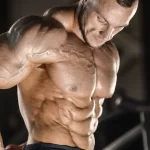We may receive a commission from our affiliate links at no additional cost to you. See disclosures page.
An athlete’s journey through the CrossFit Open is often filled with triumphs and challenges, but for Brooke Wells, this season has been particularly unique.
After an unexpected fall on ice left her with a shoulder injury, Brooke’s experience in the Open took an unforeseen turn.
Despite early success, the third workout introduced gymnastic movements that the injury hindered. With a resolve focused on long-term health and performance, she approached the workout with adaptations to maintain participation without compromising recovery.
Key Takeaways
- She faced an injury but maintained a positive focus on long-term performance.
- Adaptation and smart training choices were critical for ongoing participation in the Open.
- Full recovery for the quarterfinals remains the priority, illustrating a strategic approach to competition.
Incident Report
Slipping on Frozen Pavement
Upon returning to the gym amidst a wintry climate, she experienced a fall, resulting in an uncontrolled landing on her shoulder.
At the time, her hands were not available to break the fall due to carrying multiple items, complicating the incident further. Initially perceived as a minor injury, it was expected to resolve within a few days.
The Aftermath of the Slip
However, the discomfort persisted, leading to a decision to undergo medical imaging after three weeks of continual pain.
The MRI revealed a torn labrum—a condition not conducive to certain athletic activities involving the rig, such as bar muscle-ups, chest-to-bars, and toes-to-bars.
Fortunately, she was still capable of engaging in weightlifting despite the limitation. The event significantly affected her performance in the gymnastics segment of an athletic open, expectedly diminishing her ranking. Yet she maintained a focus on her long-term health rather than immediate competition standings.
Get Bigger Muscles
Transparent Labs Creatine HMB
4.5
Based on our testing, this is the best creatine for most people. It has the perfect dosage of creatine monohydrate per serving, which has been proven to increase muscle mass.
- Promote strength and muscle gains
- Tested for purity and safety
- Creatine has no known side effects
See on Amazon
See on Transparent Labs
Her rehabilitation protocol included modified exercises and a gradual reintroduction to pull-ups, consciously avoiding movements that could exacerbate the injury. Forward-looking and optimistic, she is intent on achieving full recovery by the time of the quarterfinals, embracing a modified training approach in preparation for future competitive events.
Managing Recovery After an Injury
Imaging and Initial Assessment
After a recent fall on ice while carrying heavy bags, an MRI was required to evaluate persistent shoulder soreness. The MRI results revealed a torn labrum, confirming the need for a modified approach to physical activity and emphasizing the necessity of understanding the extent of injuries.
Modifying Exercise Routines
Despite injury, it’s possible to continue strength training, adapting to avoid aggravating the shoulder. Exercises that don’t involve hanging from a rig, like bar muscle-ups or pull-ups, are still feasible. For example, one can perform pull-ups with reduced body weight by placing a foot on a box or opt for kipping pull-ups with limited sets to mitigate stress on the shoulder.
Prioritizing Longevity Over Immediate Success
The long-term health and performance take precedence over temporary rankings. Even at the expense of dropping positions on a leaderboard, it’s crucial to focus on comprehensive rehabilitation. This outlook involves making progress over weeks of recovery and integrating a gradual increase of training volume for exercises that are less impactful on the injury. Participating in workouts with modified elements enables continued engagement and progress tracking while nurturing the injury toward complete healing.
Experiencing the Open Exercise Routine
First Impressions of the Exercise Announcement
Upon the unveiling of the latest fitness challenge, there was a blend of anticipation and concern. The inclusion of gymnastic movements was anticipated, yet the timing in the final week brought mixed feelings. The previous weeks of the challenge were enjoyable, but the recent announcement indicated this would pose a unique hurdle.
| Timeline | Reaction | Expectations |
|---|---|---|
| Prior Weeks | Enjoyed the physical challenges | Favorable performance |
| Current Week | Mixed emotions due to injury | Lower anticipated ranking |
Adapting the Exercise Routine
In the wake of a snowstorm-related injury, which resulted in a labrum tear, adapting the workout was essential. Instead of traditional rigorous routines, substitutions such as reduced-weight pull-ups and modified handstand push-ups were integrated to maintain participation while guarding against exacerbating the injury.
- Substitutions Implemented:
- Pull-ups with foot support
- Handstand push-ups in place of bar muscle-ups
- Approach:
- Prioritized long-term health over short-term leaderboard standings
- Emphasized progressive rehabilitation over full workout completion
Psychological Outlook and Athletic Output
Maintaining mental fortitude amidst physical limitations proved crucial. The recent diagnosis could have undermined confidence, yet the strategy shifted towards valuing gradual healing over immediate competitive outcomes. The focus was on a long-term recovery plan, with the quarterfinals as the main goal for a return to peak condition.
- Mindset:
- Recovery-focused, with acceptance of temporary performance dip
- Optimistic about eventual full recovery
- Performance:
- Proceeded with the modified exercises cautiously
- Avoided activities that could hamper the healing process
Approach to Recovery
Therapeutic Exercises
Therapeutic exercises play a crucial role in the recovery process. These exercises are designed to regain strength, flexibility, and range of motion in a controlled and safe manner. The exercises may include:
- Modified Pull-Ups: Initiate with assisted pull-ups, using support such as a box under the feet to reduce body weight pressure on the shoulder.
- Standard Kipping Pull-Ups: Perform sets of kipping pull-ups with managed intensity to avoid exacerbating the shoulder condition.
Controlled Activity Escalation
Escalating activity levels gradually is key to a successful recovery, ensuring no setbacks occur during rehabilitation:
- Volume Adjustment: Introduce volume of pull-ups gradually, avoiding advanced techniques like Butterfly pull-ups that may put undue strain.
- Modified Workout Components: Replace certain exercises that may strain the shoulder with alternative movements, such as substituting handstand push-ups for bar muscle-ups.
- Paced Progression: Maintain a controlled pace during exercises, focusing on form and rehabilitation rather than speed or competition to facilitate healing.
Rethinking Competitive Priorities
Emphasizing Well-being Over Standings
In sports, the wellness of athletes should rightfully take precedence over their rankings. This approach ensures that they are focusing on their long-term health rather than just their immediate performance. A scenario that illuminates this prioritization involves an athlete navigating a post-injury period. Despite an initial fall on ice leading to a shoulder injury, the individual resisted the urge to rush back into intense competition. Instead of allowing the desire for high rankings to dictate the pace of recovery, the athlete deliberately chose activities that would not exacerbate the injury, such as modified pull-ups that reduce body weight strain on the shoulder.
| Rehabilitation Focus | Activity |
|---|---|
| Shoulder Protection | Modified Pull-ups |
| Progressive Training | Kipping Pull-ups with support |
- Avoided Movements:
- Bar Muscle-ups
- Chest to Bars
- Toast to Bars
The decision to adapt workouts and prioritize rehabilitation exercises illustrates a mature approach to competition that values longevity in the sport over transient success.
Realignment of Goals
Setting realistic expectations is crucial for an athlete recovering from an injury. Recognizing limitations and adjusting training intensity is a part of a strategic comeback. This involves accepting a temporary dip in rankings to mitigate the risk of further damage to the shoulder. It’s about being strategic: engaging in half the workout and substituting complex movements, like bar muscle-ups, with alternative exercises conducive to healing, such as handstand push-ups.
- Workout Modifications:
- Completed Only First Half of the Workout
- Substituted Handstand Push-ups for Bar Muscle-ups
The athlete’s readiness to tailor the competition around the injury reflects a dedication to long-term goals. By strategically planning training around healing and avoiding movements that could delay recovery, they lay a foundation for returning to peak performance in future competitions.
Outlook on Healing and Advancement
Progression of Healing
Weeks Since Injury: 8
Current Rehabilitation Activities:
- Modified pull-ups with reduced weight bearing.
- Sets of kipping pull-ups without strain.
Despite experiencing a fall and subsequently discovering a torn labrum, one can still perform most activities except those involving intense shoulder engagement from a suspended position, such as specific gymnastic movements on a pull-up rig.
Get Bigger Muscles
Transparent Labs Creatine HMB
4.5
Based on our testing, this is the best creatine for most people. It has the perfect dosage of creatine monohydrate per serving, which has been proven to increase muscle mass.
- Promote strength and muscle gains
- Tested for purity and safety
- Creatine has no known side effects
See on Amazon
See on Transparent Labs
Pain Management and Activity: Ability to lift and engage in rehab activities indicates a favorable healing trajectory.
Targets for Upcoming Quarterfinals
Rehabilitation Goals:
- Continue with rehabilitation exercises, aiming for pain-free execution.
- Gradual increase in exercise volume to rebuild capacity without exacerbating the injury.
Performance Objectives for Quarterfinals:
- Achieve full shoulder function to competitively perform in quarterfinals.
- Engage in all necessary movements confidently and without discomfort, ensuring readiness for competitive demands.
Given the current progress and a strategic approach to rehabilitation, there is a strong expectation that one will be restored to peak condition for the quarterfinals, underscoring the importance of an effective long-term health strategy over short-term competitive gains.
Musings on Training and Recuperation
Challenges and Reverses
During winter, an unforeseen slip on the ice while encumbered with gear led to a shoulder injury. Initial expectations were for a brief discomfort; however, the pain persisted. The decision to undergo an MRI was driven by a desire for reassurance, which was unfortunately met with the discovery of a torn labrum. Despite limitations imposed primarily by rig-related activities—such as bar muscle-ups, chest-to-bars, and other similar movements—the ability to continue weightlifting remained unaffected.
Maintaining Optimism and Taking Initiative
In response to the physical setback, a focus was maintained on the broader journey rather than short-term placements in competitive standings. Acknowledging progress over the eight weeks post-injury coincided with the beginning of the healing process. Adaptations to training regimen included modified pull-ups and a tailored version of a workout with substituted elements to accommodate physical limitations while continuing participation in competitive events. The approach embraced rehabilitation movements and a gradual increase in workout intensity, while refraining from exacerbating the injury. Confidence was expressed in a full recovery by the time subsequent significant competitions commenced, underlining the commitment to health and progress in the sport.
Recap of Recent Training Session
In the most recent phase of training, the focus has been on adapting to physical limitations following an unexpected injury. After a fall on ice while carrying bags to the gym, an initial belief that the injury would resolve itself in a few days transformed into a realization of a torn labrum. Despite this setback, the training has been resilient, avoiding specific movements that aggravate the shoulder, such as exercises on the rig, while still engaging in other forms of strength training.
| Activity Type | Detail | Adaptation |
|---|---|---|
| Injury | Shoulder injury due to fall on ice | Limited rig movements; focus on recovery |
| Gymnastic Movements | Bar muscleups, chest to bars, toasts to bars avoided | Modified pull-ups and substitutions |
| Weight Lifting | Unaffected by shoulder condition | Continued as normal component of the program |
| Rehab Work | Gradual reintroduction to gymnastic movements | Slowly increasing volume; no butterfly pull-ups |
Prospects for the Upcoming Season
Looking forward, there is an emphasis on the long-term goal of full recovery and optimal performance, rather than immediate standings in competitive events. Progress has reached a point where rehabilitative exercise routines are increasing in volume, albeit at a monitored pace.
- Progression has been noted with two sets of five kipping pull-ups.
- Instead of bar muscle-ups, 14 handstand push-ups have been incorporated to maintain participation.
- Mindful of healing timeline, with expectations set to be fit for quarterfinals.
This careful and strategic approach ensures sustained health and preparation for the intensity of the competitive season ahead. Full participation in the open with modifications reflects both dedication and a realistic strategy for maintaining competitive readiness.





